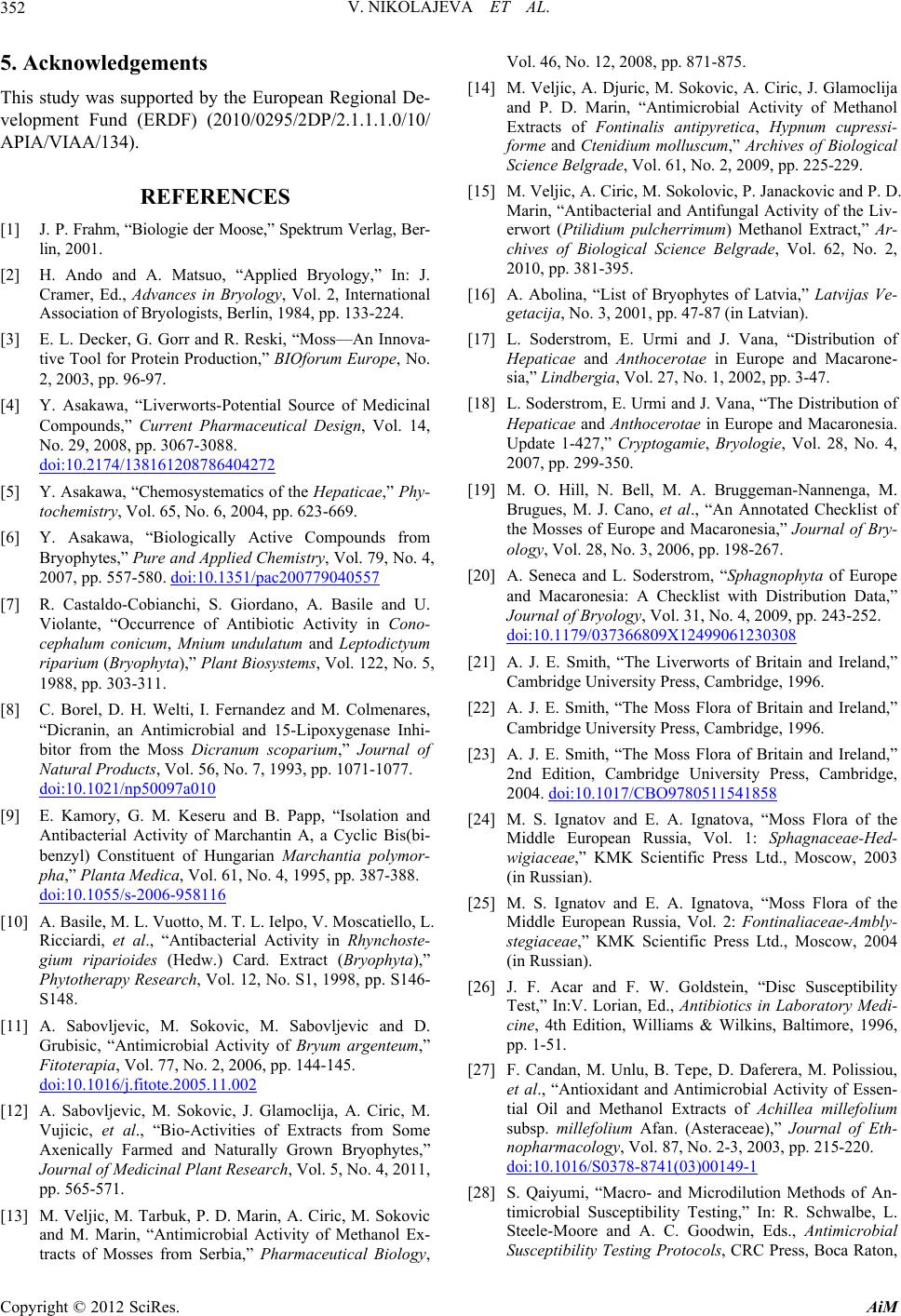
V. NIKOLAJEVA ET AL.
Copyright © 2012 SciRes. AiM
352
5. Acknowledgements
This study was supported by the European Regional De-
velopment Fund (ERDF) (2010/0295/2DP/2.1.1.1.0/10/
APIA/VIAA/134).
REFERENCES
[1] J. P. Frahm, “Biologie der Moose,” Spektrum Verlag, Ber-
lin, 2001.
[2] H. Ando and A. Matsuo, “Applied Bryology,” In: J.
Cramer, Ed., Advances in Bryology, Vol. 2, International
Association of Bryologists, Berlin, 1984, pp. 133-224.
[3] E. L. Decker, G. Gorr and R. Reski, “Moss—An Innova-
tive Tool for Protein Production,” BIOforum Europe, No.
2, 2003, pp. 96-97.
[4] Y. Asakawa, “Liverworts-Potential Source of Medicinal
Compounds,” Current Pharmaceutical Design, Vol. 14,
No. 29, 2008, pp. 3067-3088.
doi:10.2174/138161208786404272
[5] Y. Asakawa, “Chemosystematics of the Hepaticae,” Phy-
tochemistry, Vol. 65, No. 6, 2004, pp. 623-669.
[6] Y. Asakawa, “Biologically Active Compounds from
Bryophytes,” Pure and Applied Chemistry, Vol. 79, No. 4,
2007, pp. 557-580. doi:10.1351/pac200779040557
[7] R. Castaldo-Cobianchi, S. Giordano, A. Basile and U.
Violante, “Occurrence of Antibiotic Activity in Cono-
cephalum conicum, Mnium undulatum and Leptodictyum
riparium (Bryophyta),” Plant Biosystems, Vol. 122, No. 5,
1988, pp. 303-311.
[8] C. Borel, D. H. Welti, I. Fernandez and M. Colmenares,
“Dicranin, an Antimicrobial and 15-Lipoxygenase Inhi-
bitor from the Moss Dicranum scoparium,” Journal of
Natural Products, Vol. 56, No. 7, 1993, pp. 1071-1077.
doi:10.1021/np50097a010
[9] E. Kamory, G. M. Keseru and B. Papp, “Isolation and
Antibacterial Activity of Marchantin A, a Cyclic Bis(bi-
benzyl) Constituent of Hungarian Marchantia polymor-
pha,” Planta Medica, Vol. 61, No. 4, 1995, pp. 387-388.
doi:10.1055/s-2006-958116
[10] A. Basile, M. L. Vuotto, M. T. L. Ielpo, V. Moscatiello, L.
Ricciardi, et al., “Antibacterial Activity in Rhynchoste-
gium riparioides (Hedw.) Card. Extract (Bryophyta),”
Phytotherapy Research, Vol. 12, No. S1, 1998, pp. S146-
S148.
[11] A. Sabovljevic, M. Sokovic, M. Sabovljevic and D.
Grubisic, “Antimicrobial Activity of Bryum argenteum,”
Fitoterapia, Vol. 77, No. 2, 2006, pp. 144-145.
doi:10.1016/j.fitote.2005.11.002
[12] A. Sabovljevic, M. Sokovic, J. Glamoclija, A. Ciric, M.
Vujicic, et al., “Bio-Activities of Extracts from Some
Axenically Farmed and Naturally Grown Bryophytes,”
Journal of Medicinal Plant Research, Vol. 5, No. 4, 2011,
pp. 565-571.
[13] M. Veljic, M. Tarbuk, P. D. Marin, A. Ciric, M. Sokovic
and M. Marin, “Antimicrobial Activity of Methanol Ex-
tracts of Mosses from Serbia,” Pharmaceutical Biology,
Vol. 46, No. 12, 2008, pp. 871-875.
[14] M. Veljic, A. Djuric, M. Sokovic, A. Ciric, J. Glamoclija
and P. D. Marin, “Antimicrobial Activity of Methanol
Extracts of Fontinalis antipyretica, Hypnum cupressi-
forme and Ctenidium molluscum,” Archives of Biological
Science Belgrade, Vol. 61, No. 2, 2009, pp. 225-229.
[15] M. Veljic, A. Ciric, M. Sokolovic, P. Janackovic and P. D.
Marin, “Antibacterial and Antifungal Activity of the Liv-
erwort (Ptilidium pulcherrimum) Methanol Extract,” Ar-
chives of Biological Science Belgrade, Vol. 62, No. 2,
2010, pp. 381-395.
[16] A. Abolina, “List of Bryophytes of Latvia,” Latvijas Ve-
getacija, No. 3, 2001, pp. 47-87 (in Latvian).
[17] L. Soderstrom, E. Urmi and J. Vana, “Distribution of
Hepaticae and Anthocerotae in Europe and Macarone-
sia,” Lindbergia, Vol. 27, No. 1, 2002, pp. 3-47.
[18] L. Soderstrom, E. Urmi and J. Vana, “The Distribution of
Hepaticae and Anthocerotae in Europe and Macaronesia.
Update 1-427,” Cryptogamie, Bryologie, Vol. 28, No. 4,
2007, pp. 299-350.
[19] M. O. Hill, N. Bell, M. A. Bruggeman-Nannenga, M.
Brugues, M. J. Cano, et al., “An Annotated Checklist of
the Mosses of Europe and Macaronesia,” Journal of Bry-
ology, Vol. 28, No. 3, 2006, pp. 198-267.
[20] A. Seneca and L. Soderstrom, “Sphagnophyta of Europe
and Macaronesia: A Checklist with Distribution Data,”
Journal of Bryology, Vol. 31, No. 4, 2009, pp. 243-252.
doi:10.1179/037366809X12499061230308
[21] A. J. E. Smith, “The Liverworts of Britain and Ireland,”
Cambridge University Press, Cambridge, 1996.
[22] A. J. E. Smith, “The Moss Flora of Britain and Ireland,”
Cambridge University Press, Cambridge, 1996.
[23] A. J. E. Smith, “The Moss Flora of Britain and Ireland,”
2nd Edition, Cambridge University Press, Cambridge,
2004. doi:10.1017/CBO9780511541858
[24] M. S. Ignatov and E. A. Ignatova, “Moss Flora of the
Middle European Russia, Vol. 1: Sphagnaceae-Hed-
wigiaceae,” KMK Scientific Press Ltd., Мoscow, 2003
(in Russian).
[25] M. S. Ignatov and E. A. Ignatova, “Moss Flora of the
Middle European Russia, Vol. 2: Fontinaliaceae-Ambly-
stegiaceae,” KMK Scientific Press Ltd., Мosсow, 2004
(in Russian).
[26] J. F. Acar and F. W. Goldstein, “Disc Susceptibility
Test,” In:V. Lorian, Ed., Antibiotics in Laboratory Medi-
cine, 4th Edition, Williams & Wilkins, Baltimore, 1996,
pp. 1-51.
[27] F. Candan, M. Unlu, B. Tepe, D. Daferera, M. Polissiou,
et al., “Antioxidant and Antimicrobial Activity of Essen-
tial Oil and Methanol Extracts of Achillea millefolium
subsp. millefolium Afan. (Asteraceae),” Journal of Eth-
nopharmacology, Vol. 87, No. 2-3, 2003, pp. 215-220.
doi:10.1016/S0378-8741(03)00149-1
[28] S. Qaiyumi, “Macro- and Microdilution Methods of An-
timicrobial Susceptibility Testing,” In: R. Schwalbe, L.
Steele-Moore and A. C. Goodwin, Eds., Antimicrobial
Susceptibility Testing Protocols, CRC Press, Boca Raton,